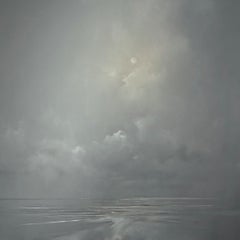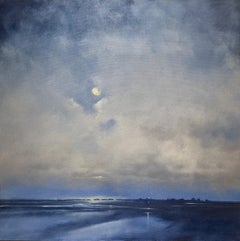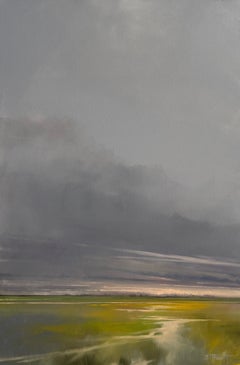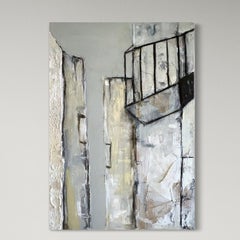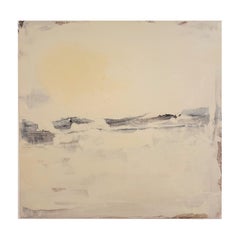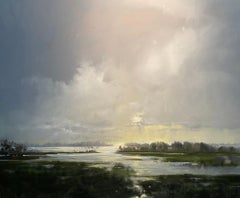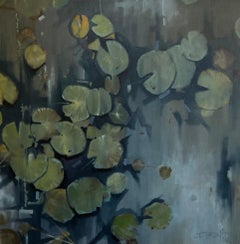Doug Foltz Art
to
1
2
Overall Width
to
Overall Height
to
3
3
2
1
3
3
3
3
3
1
1
3
3
3
3
3
9,103
2,808
2,504
1,350
3
Artist: Doug Foltz
She Was Always Quick by Doug Foltz Oil on Canvas Low Country Landscape Blues
By Doug Foltz
Located in Atlanta, GA
Known for his luminous, atmospheric landscapes, Doug Foltz masterfully captures both vastness and intimacy in She Was Always Quick to Forgive. Rendered in soft tonal grays and silver...
Category
21st Century and Contemporary Contemporary Doug Foltz Art
Materials
Canvas, Oil
Catching Her Breath by Doug Foltz Oil on Canvas Low Country Landscape Blues
By Doug Foltz
Located in Atlanta, GA
Doug Foltz — Catching Her Breath
Oil on Canvas, 36 x 36 inches
Renowned contemporary landscape artist Doug Foltz is celebrated for his luminous horizons and atmospheric seascapes th...
Category
21st Century and Contemporary Contemporary Doug Foltz Art
Materials
Canvas, Oil
Do You Remember When by Doug Foltz Oil on Canvas Low Country Landscape
By Doug Foltz
Located in Atlanta, GA
Doug Foltz — Do You Remember When We Used to Sing
Oil on Canvas, 40 x 60 inches
Acclaimed contemporary painter Doug Foltz is celebrated for his evocative landscapes that capture bot...
Category
21st Century and Contemporary Contemporary Doug Foltz Art
Materials
Canvas, Oil
Related Items
"Cityscape" Abstract Mixed Media Paint on Canvas , Made in Italy
By Marilina Marchica
Located in Agrigento, AG
Cityscape
mixed media on Cavas
70x100 cm
Original Art Ready to Hang
Architecture
Category Painting
Year 2013
Mediums, Materials, Styles
Mediums Enamel, Oil, Gesso
Materials Canvas
...
Category
2010s Contemporary Doug Foltz Art
Materials
Enamel
$2,612
H 39.38 in W 27.56 in D 1.38 in
" White Landscape " Abstract Painting, One of a Kind , made in Italy
By Marilina Marchica
Located in Agrigento, AG
Landscape
mixed media on canvas
50x50 cm
Original Art
Ready to Hang
her painting tells of the relationship between man, nature and time, the landscape, the sign and the trace,
thr...
Category
2010s Contemporary Doug Foltz Art
Materials
Enamel
$1,495 Sale Price
20% Off
H 19.69 in W 19.69 in D 1.19 in
Zhao Wang Surrealist Original Oil Painting "Running"
Located in New York, NY
Title: Running
Medium: Oil on canvas
Size: 8 x 8 inches
Frame: Framing options available!
Condition: The painting appears to be in excellent condition.
Note: This painting is unstretched
Year: 2000 Circa
Artist: Zhao Wang...
Category
21st Century and Contemporary Contemporary Doug Foltz Art
Materials
Canvas, Oil
$500 Sale Price
50% Off
H 8 in W 8 in
Antique beauty - Oil Paint by Elena Mardashova - 2024
Located in Roma, IT
'Antique beauty'. Oil painting on canvas 50 x 60 cm, 2024.
Category
2010s Contemporary Doug Foltz Art
Materials
Oil, Canvas
$958
H 19.69 in W 23.63 in D 0.79 in
Dancing Light 4551
By Kate Salenfriend
Located in Napa, CA
Surrounded by artistic inspiration from a very early age, Kate Salenfriend learned most of her technical skills from her great-grandfather, Stewart Robertson, the registered Californ...
Category
2010s Contemporary Doug Foltz Art
Materials
Gold Leaf
“Blue Landscape – Original Abstract Painting on Paper by Marilina Marchica
By Marilina Marchica
Located in Agrigento, AG
Description:
Blue Landscape is an original abstract painting by Italian artist Marilina Marchica, created in 2025 using pure pigment on Paper. The artwork measures 54x 50 cm .
This p...
Category
2010s Contemporary Doug Foltz Art
Materials
Cotton Canvas, Oil
$1,246 Sale Price
20% Off
H 21.26 in W 19.69 in D 0.79 in
Landscape , Contemporary Paint on Cotton Canvas , Art By Marilina Marchica
By Marilina Marchica
Located in Agrigento, AG
Title: Landscape
Year: 2024
Technique: mixed media on Cotton Canvas
100x105 cm
Description:
This original work by Marilina Marchica explores the relationship between man, nature...
Category
2010s Contemporary Doug Foltz Art
Materials
Enamel
$3,067
H 41.34 in W 39.38 in D 0.99 in
Vintage Impasto Impressionist Oil Painting of a Winter Landscape in England
Located in Preston, GB
Vintage Impasto Impressionist Winter Landscape Painting of a Misty Morning at a Reservoir in the Peak District National Park in Northern England, by 20th Century British Artist.
Art measures 33 x 21 inches
Frame measures 39 x 27 inches
(framed in a hand-painted vintage wooden moulding in magnolia)
This is a rare early atmospheric work in impasto oils from 1971, using muted pastel colours, in very good original condition. There is an evocative sense of the light beating down onto the water in this Winter Landscape painting. Reframed in a vintage wooden moulding painted in magnolia, signed and dated on the front of the canvas, with full authentication.
Born in Birmingham in 1948, Rex Preston...
Category
1970s Contemporary Doug Foltz Art
Materials
Canvas, Oil
$3,436 Sale Price
33% Off
H 27 in W 39 in D 3 in
"Garden Landscape with Water Views" Louis Comfort Tiffany Style Oil Painting
By Kristina Nemethy
Located in New York, NY
This piece is a bold depiction of an abstract landscape with a colorful and expressive nature. Nemethy uses techniques borrowed from early Tiffany stained glass windows...
Category
21st Century and Contemporary Contemporary Doug Foltz Art
Materials
Canvas, Oil
$5,500
H 30 in W 40 in D 1 in
Yellow Abstract Landscape – Original Mixed Media and Pastel on Canvas
By Marilina Marchica
Located in Agrigento, AG
Artist: Marilina Marchica
Title: Yellow Landscape
Year: 2021
Dimensions: 46 x 61 x 3.8 cm
Medium: Mixed media and pastel on canvas
Condition: Excellent
Framing: Not framed, edges pai...
Category
2010s Contemporary Doug Foltz Art
Materials
Canvas, Pastel, Oil
$1,868
H 24.02 in W 18.12 in D 0.79 in
"Romantic Landscape with Pond View" Louis Comfort Tiffany Style Oil Painting
By Kristina Nemethy
Located in New York, NY
This piece is a bold depiction of an abstract landscape with a colorful and expressive nature. Nemethy uses techniques borrowed from early Tiffany stained glass windows...
Category
21st Century and Contemporary Contemporary Doug Foltz Art
Materials
Canvas, Oil
$5,500
H 37.5 in W 47.5 in D 1 in
"White Landscape" Abstract landscape Painting , Original art Made in Italy
By Marilina Marchica
Located in Agrigento, AG
White Landscape
oil on canvas 60x81cm
2025
original art
Ready to hang
certificate of authenticity included
Marilina Marchica was born in Agrigento, where she works and lives,
Afte...
Category
2010s Contemporary Doug Foltz Art
Materials
Canvas, Oil, Pigment
$2,037
H 31.89 in W 23.63 in D 0.79 in
Previously Available Items
Face to Face by Doug Foltz Oil on Canvas Horizontal Low Country Landscape
By Doug Foltz
Located in Atlanta, GA
Doug says, "There is great joy in seeking new places - both literal and figurative... finding something new about the world, and more importantly, the relationship we share with it. ...
Category
21st Century and Contemporary Contemporary Doug Foltz Art
Materials
Canvas, Oil
Some Edges Are Meant to Be Broken by Doug Foltz Oil on Canvas Landscape Lily Pad
By Doug Foltz
Located in Atlanta, GA
Doug says, "There is great joy in seeking new places - both literal and figurative... finding something new about the world, and more importantly, the relationship we share with it. Painting has long been a way for me to indulge that exploration and I work hard to nurture the creative spirit in everything around me. I find great peace and power in nature… and great energy in curiosity, exploration and discovery - of any kind. I am fascinated with water and light and believe that composition is king. My fascination with graphic composition and shifting light have always pushed paintings that I hope open new views of both the expanse and the detail of the coastal landscape. Most often referenced as "interpretive" they easily depart to explore more abstract or distant characters... usually returning once again to rest comfortably at home… inevitably being less about the way a place looks than the way it makes me feel."
He was born and raised by rebellious New England parents in Miami, Florida and holds a Bachelors of Environmental Design and Bachelors of Architecture - Auburn University...
Category
21st Century and Contemporary Contemporary Doug Foltz Art
Materials
Canvas, Oil
Approaching Abandon by Doug Foltz Square Black and White Oil on Canvas Landscape
By Doug Foltz
Located in Atlanta, GA
Doug says, "There is great joy in seeking new places - both literal and figurative... finding something new about the world, and more importantly, the relationship we share with it. ...
Category
21st Century and Contemporary Contemporary Doug Foltz Art
Materials
Canvas, Oil
More Than Just a Memory by Doug Foltz, Square Oil on Canvas Landscape
By Doug Foltz
Located in Atlanta, GA
'More Than Just a Memory' is a large contemporary oil on canvas landscape painting created by American artist Doug Foltz in 2021. Featuring a palette made of grey, blue, white and gr...
Category
21st Century and Contemporary Contemporary Doug Foltz Art
Materials
Canvas, Oil
H 48 in W 48 in D 2 in
Falling Into Place by Doug Foltz, Large Contemporary Horizontal Landscape
By Doug Foltz
Located in Atlanta, GA
Doug says, "There is great joy in seeking new places - both literal and figurative... finding something new about the world, and more importantly, the relationship we share with it. ...
Category
21st Century and Contemporary Contemporary Doug Foltz Art
Materials
Canvas, Oil
As is You Never Left by Doug Foltz, Large Vertical Contemporary Landscape
By Doug Foltz
Located in Atlanta, GA
Doug says, "There is great joy in seeking new places - both literal and figurative... finding something new about the world, and more importantly, the relationship we share with it. ...
Category
21st Century and Contemporary Contemporary Doug Foltz Art
Materials
Canvas, Oil
Still Too by Doug Foltz, Large Square Contemporary Seascape
By Doug Foltz
Located in Atlanta, GA
Doug says, "There is great joy in seeking new places - both literal and figurative... finding something new about the world, and more importantly, the relationship we share with it. ...
Category
21st Century and Contemporary Contemporary Doug Foltz Art
Materials
Canvas, Oil
Just Breathe by Doug Foltz, Large Contemporary Square Seascape
By Doug Foltz
Located in Atlanta, GA
Doug says, "There is great joy in seeking new places - both literal and figurative... finding something new about the world, and more importantly, the relationship we share with it. ...
Category
21st Century and Contemporary Contemporary Doug Foltz Art
Materials
Canvas, Oil
H 48 in W 48 in D 2 in
Late Harvest by Doug Foltz, Large Square Contemporary Seascape
By Doug Foltz
Located in Atlanta, GA
'Late Harvest' is a large contemporary oil on canvas seascape painting created by American artist Doug Foltz in 2019. Featuring a palette made of grey, blue, white and neutrals among...
Category
21st Century and Contemporary Contemporary Doug Foltz Art
Materials
Canvas, Oil
And Then It Began by Doug Foltz, Large Contemporary Square Seascape
By Doug Foltz
Located in Atlanta, GA
'And Then It Began' is a large contemporary oil on canvas seascape painting created by American artist Doug Foltz in 2019. Featuring a soft palette made of grey, blue and white, the ...
Category
21st Century and Contemporary Contemporary Doug Foltz Art
Materials
Canvas, Oil
H 48 in W 48 in D 2 in
The Dance Between Distance and Where It Began by Doug Foltz, Large Contemporary
By Doug Foltz
Located in Atlanta, GA
'The Dance Between Distance and Where It Began' is a large contemporary oil on canvas seascape painting created by American artist Doug Foltz in 2019. Featuring a palette made of gre...
Category
21st Century and Contemporary Contemporary Doug Foltz Art
Materials
Canvas, Oil
Baker Run-Southern Waterway Series #2 by Doug Foltz, Large Landscape Painting
By Doug Foltz
Located in Atlanta, GA
'Baker Run-Southern Waterway Series #2' is a large contemporary landscape painting of square format, created by American artist Doug Foltz in 2019. Featuring a palette made of blue, ...
Category
21st Century and Contemporary Contemporary Doug Foltz Art
Materials
Canvas, Oil
Doug Foltz art for sale on 1stDibs.
Find a wide variety of authentic Doug Foltz art available for sale on 1stDibs. If you’re browsing the collection of art to introduce a pop of color in a neutral corner of your living room or bedroom, you can find work that includes elements of blue and other colors. You can also browse by medium to find art by Doug Foltz in canvas, fabric, oil paint and more. Much of the original work by this artist or collective was created during the 21st century and contemporary and is mostly associated with the contemporary style. Not every interior allows for large Doug Foltz art, so small editions measuring 40 inches across are available. Customers who are interested in this artist might also find the work of Timothy Tompkins, Eric Jon Holswade, and Jerry Malzahn. Doug Foltz art prices can differ depending upon medium, time period and other attributes. On 1stDibs, the price for these items starts at $7,600 and tops out at $9,800, while the average work can sell for $9,000.
